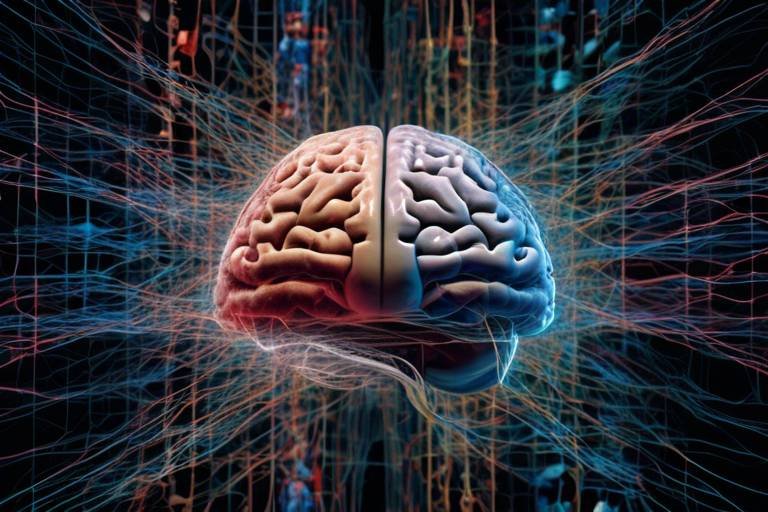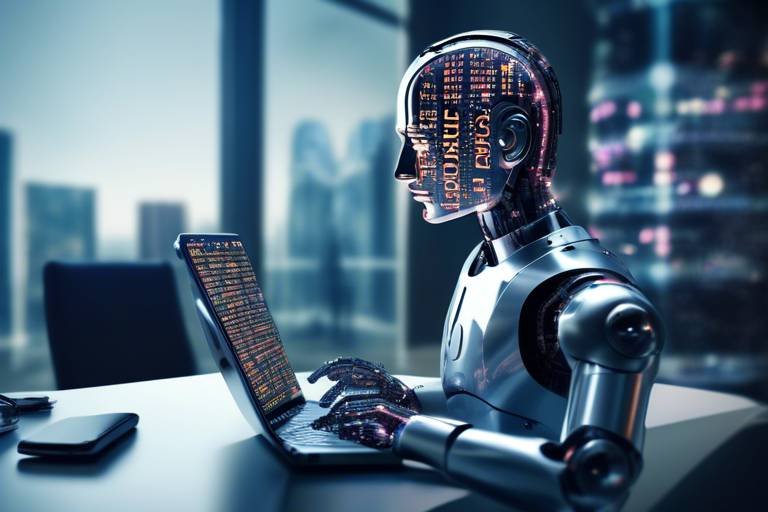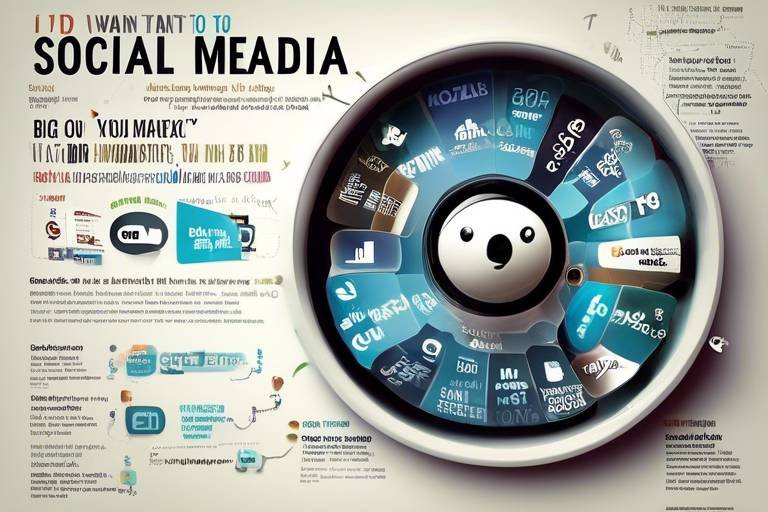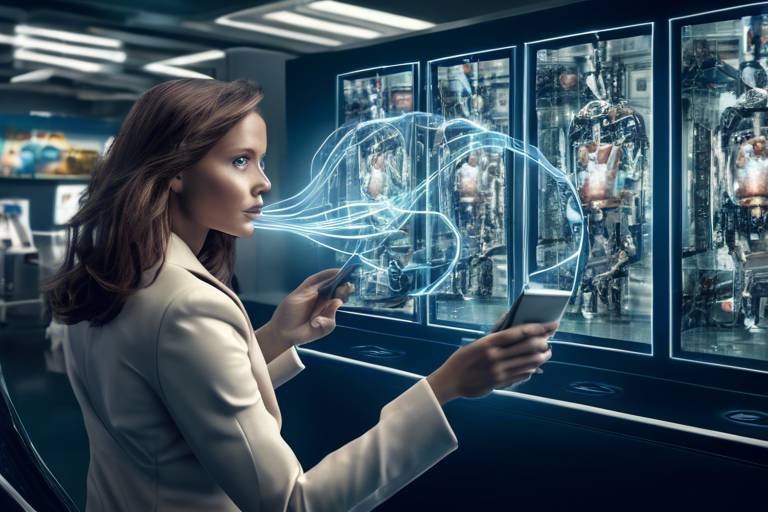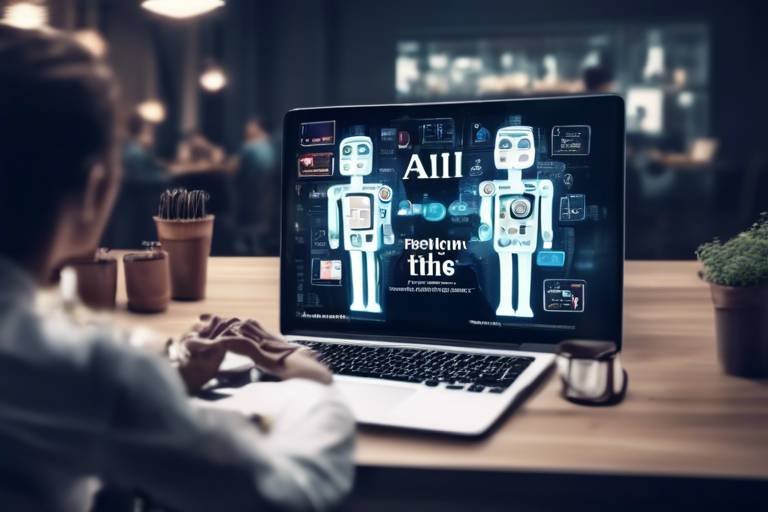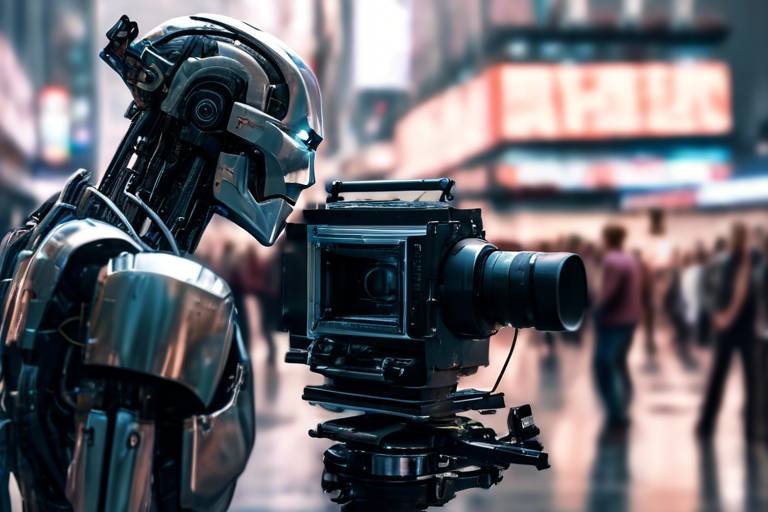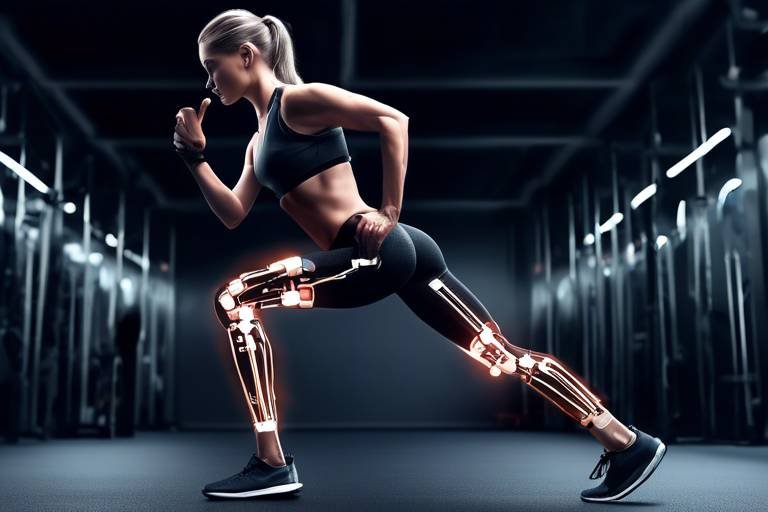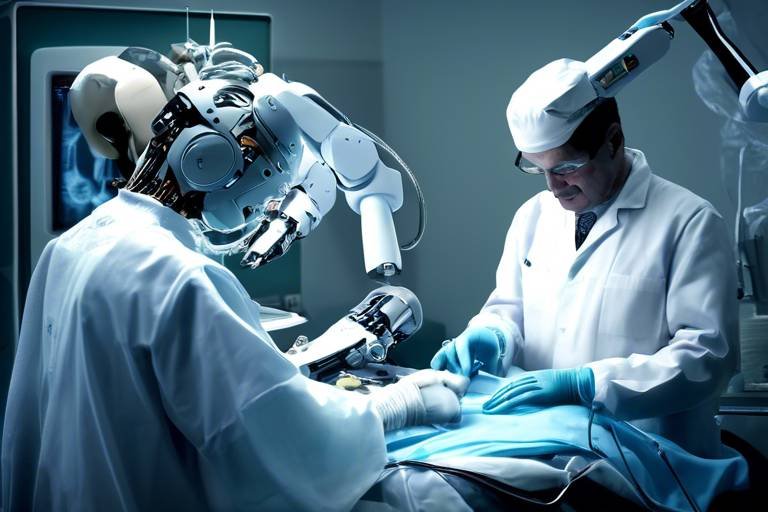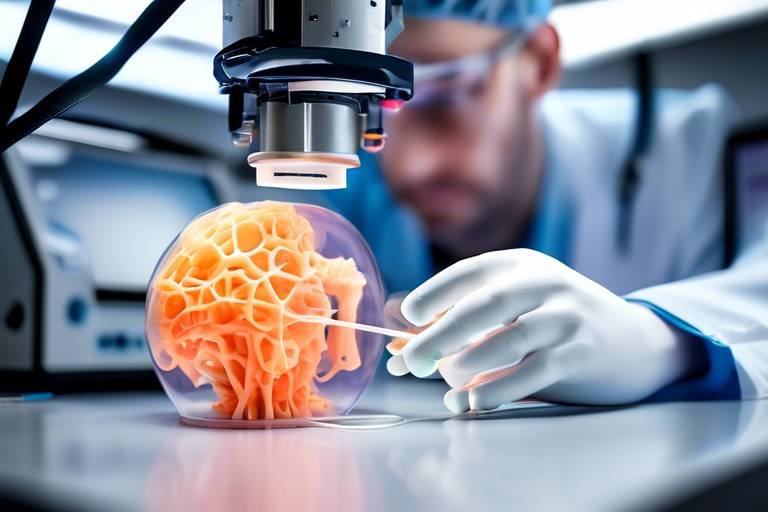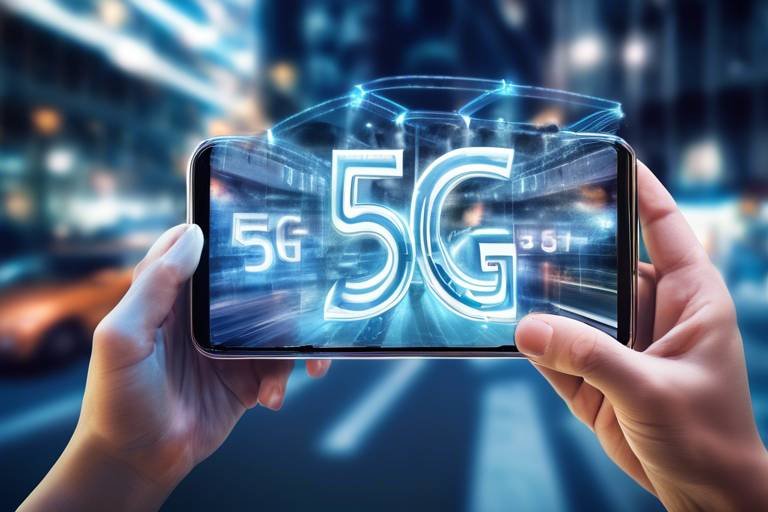Biometric Technology: The Future of Security
In a world where security threats are evolving at an unprecedented pace, biometric technology emerges as a beacon of hope. This innovative approach to security leverages unique biological traits to authenticate individuals, making it increasingly difficult for unauthorized users to gain access to sensitive information or restricted areas. Imagine a world where you can simply walk into a building, and your face or fingerprint grants you instant entry—no keys, no cards, just you. Sounds futuristic, right? But the truth is, we are already living in that reality!
Biometric technology encompasses a range of techniques that measure and analyze human characteristics. From fingerprints to iris scans, each method offers distinct advantages and challenges. As we delve deeper into this fascinating subject, we will explore the various types of biometric identifiers, their applications across different sectors, and the implications for privacy and safety. Are you ready to unlock the secrets of biometric technology? Let’s dive in!
At its core, biometric technology is about ensuring that the person trying to gain access is indeed who they claim to be. This is achieved through the analysis of unique biological traits. But how does it work? The process typically involves capturing a sample of a biometric trait, converting it into a digital format, and then comparing it against a stored template to verify identity. This sounds simple, but the technology behind it is anything but.
There are several types of biometric identifiers available today, including:
- Fingerprint Recognition
- Facial Recognition
- Iris Scanning
- Voice Recognition
Each of these methods has its unique strengths and weaknesses, which we will explore in detail in the following sections. The beauty of biometric technology lies in its ability to provide a higher level of security than traditional methods, such as passwords or PINs, which can be easily forgotten or stolen.
Now that we have a basic understanding of biometric technology, let's take a closer look at the various types of biometric identifiers and their specific applications in security.
One of the most widely recognized forms of biometric technology is fingerprint recognition. This method analyzes the unique patterns of ridges and valleys on an individual’s fingertips. It’s like having a personal signature that can’t be replicated. Fingerprint recognition is commonly used in smartphones, security systems, and even in law enforcement. However, while it boasts high accuracy rates, it also faces challenges, particularly in terms of security and privacy.
Fingerprint recognition systems offer several advantages:
- Ease of Use: Users simply place their finger on a scanner—no complicated steps involved.
- Cost-Effectiveness: Fingerprint scanners are generally less expensive than other biometric systems.
- Widespread Acceptance: This technology is already familiar to many people, increasing its adoption rate.
However, it’s not all smooth sailing. Fingerprint recognition systems face challenges, including:
- Spoofing: Criminals can attempt to replicate fingerprints using molds.
- Data Storage Issues: Storing biometric data securely is crucial to prevent unauthorized access.
Another popular biometric method is facial recognition technology. This technology analyzes facial features, such as the distance between the eyes or the shape of the jawline. It’s used in various applications, from unlocking smartphones to enhancing security in public spaces. However, ethical considerations arise, particularly concerning privacy and surveillance. As we embrace this technology, we must also consider its implications on our civil liberties.
Biometric technology is not just a futuristic concept; it’s actively being implemented across various sectors, enhancing security and efficiency in ways we never thought possible.
In the banking sector, biometric technology plays a crucial role in fraud prevention and customer authentication. Imagine walking into your bank and verifying your identity with just your fingerprint or face—no more fumbling with cards or remembering complex passwords. Financial institutions are increasingly adopting biometric systems to enhance security and provide a seamless customer experience.
In healthcare, biometric technology is revolutionizing patient identification and data security. With the ability to accurately identify patients, healthcare providers can reduce errors and ensure that sensitive medical information remains confidential. This is particularly important in an era where data breaches are all too common. By implementing biometric systems, healthcare facilities can enhance patient safety and privacy.
- What is biometric technology? Biometric technology uses unique biological traits to verify identity, such as fingerprints or facial recognition.
- What are the advantages of biometric security? Advantages include enhanced security, ease of use, and reduced reliance on passwords.
- Are there privacy concerns with biometric technology? Yes, the collection and storage of biometric data raise significant privacy and ethical concerns.

The Basics of Biometric Technology
In today's fast-paced world, biometric technology stands as a revolutionary advancement in the field of security. But what exactly does this term encompass? At its core, biometric technology refers to the measurement and statistical analysis of people's unique physical and behavioral characteristics. This technology relies on the idea that each individual possesses distinct traits that can be quantified and used for identification and authentication purposes. Imagine trying to unlock your phone with just a glance or a touch of your finger. That's the magic of biometrics!
So, how does it work? Biometric systems typically involve three main processes: data capture, feature extraction, and matching. Initially, the system captures a biometric sample, such as a fingerprint or facial image. This sample is then converted into a digital format, which allows the system to extract unique features that differentiate one individual from another. Finally, the extracted features are compared against a database to verify identity. This process is not only swift but also remarkably accurate, making it an attractive option for various security applications.
There are several types of biometric identifiers available today, each with its own set of benefits and challenges. Among the most common are:
- Fingerprint recognition: Utilizing the unique patterns found on fingertips.
- Facial recognition: Analyzing facial features to identify individuals.
- Iris scanning: Examining the unique patterns in the colored part of the eye.
- Voice recognition: Identifying individuals based on their vocal characteristics.
As we delve deeper into the world of biometric technology, it's essential to consider not just its functionalities but also its implications for privacy and security. The advancement of this technology prompts questions about how personal data is stored and protected. After all, with great power comes great responsibility. As biometric systems become more integrated into daily life, the balance between convenience and privacy will remain a crucial topic of discussion.
In conclusion, understanding the basics of biometric technology is vital as we navigate an increasingly digital world. The capabilities of this technology are expanding rapidly, enhancing security measures across various sectors while also raising important ethical considerations. As we explore the different types of biometric identifiers and their applications in the following sections, we will uncover both the advantages and challenges that come with this cutting-edge technology.
- What is biometric technology? - Biometric technology involves the measurement of unique physical and behavioral characteristics for identification purposes.
- How does biometric authentication work? - It captures a biometric sample, extracts unique features, and compares them against a database for verification.
- What are the common types of biometric identifiers? - Common types include fingerprint recognition, facial recognition, iris scanning, and voice recognition.
- Are biometric systems secure? - While they offer enhanced security, concerns about data privacy and potential vulnerabilities exist.

Types of Biometric Identifiers
When we talk about biometric technology, we are diving into a fascinating realm where our unique physical and behavioral traits become the keys to our security. This technology has revolutionized the way we think about identification and access control. But what exactly are these biometric identifiers? Simply put, they are measurable biological characteristics that can be used to verify an individual's identity. In this section, we will explore the most common types of biometric identifiers, each with its own set of advantages and challenges.
First up is fingerprint recognition, one of the oldest and most widely used biometric methods. Fingerprints are unique to each individual, making them a reliable form of identification. This technology works by scanning the ridges and valleys of a person's fingerprint and comparing it to a stored template. However, while fingerprint recognition is generally accurate, it does have its drawbacks, such as susceptibility to spoofing—where someone uses a fake fingerprint to gain unauthorized access.
Next, we have facial recognition technology. This method analyzes facial features and compares them to a database of known faces. It's becoming increasingly popular in security systems, law enforcement, and even in our smartphones. But, with great power comes great responsibility. The ethical implications surrounding privacy and surveillance are hot topics of discussion. Are we sacrificing our privacy for security? This is a question we need to ponder as facial recognition technology becomes more prevalent.
Another fascinating biometric identifier is iris scanning. Iris recognition technology uses the unique patterns in the colored part of our eyes to identify individuals. The accuracy of this method is incredibly high, making it a strong contender for secure environments. However, the technology can be expensive and requires specialized equipment, which might limit its widespread adoption.
Lastly, let’s not forget about voice recognition. This method analyzes the unique characteristics of a person's voice, including pitch, tone, and speech patterns. It’s particularly useful in scenarios where hands-free operation is essential. However, voice recognition can be affected by background noise and can sometimes be fooled by recorded voices, raising questions about its reliability in high-stakes situations.
In summary, the world of biometric identifiers is vast and varied. Each type of biometric technology has its unique advantages and disadvantages, making them suitable for different applications. As we continue to embrace these technologies, it’s crucial to remain aware of the implications they carry for our privacy and security. Here’s a quick comparison of the different types:
| Biometric Identifier | Advantages | Disadvantages |
|---|---|---|
| Fingerprint Recognition | Cost-effective, widely accepted | Vulnerable to spoofing |
| Facial Recognition | Fast and non-intrusive | Privacy concerns, ethical issues |
| Iris Scanning | Highly accurate | Expensive, requires specialized equipment |
| Voice Recognition | Hands-free operation | Affected by background noise, can be fooled by recordings |
As technology advances, we can expect to see even more innovative biometric solutions emerging. The challenge will be to balance the benefits of enhanced security with the need to protect our personal privacy.

Fingerprint Recognition
Fingerprint recognition technology has emerged as one of the most widely adopted forms of biometric identification, and for good reason. This method leverages the unique patterns found in each individual's fingerprints, making it a highly effective way to authenticate identity. But how does it actually work? In simple terms, when a person places their finger on a scanner, the device captures an image of the fingerprint and converts it into a digital format. This digital representation is then compared to stored templates to verify the identity of the individual. The accuracy of this technology is impressive, with modern systems boasting a recognition rate that can exceed 99%. However, like any technology, it comes with its own set of challenges.
One of the most significant advantages of fingerprint recognition systems is their ease of use. Users simply need to place their finger on a scanner, and the system does the rest. This simplicity has led to widespread acceptance across various industries, from smartphones to banking systems. Moreover, fingerprint scanners are generally cost-effective, making them accessible for businesses of all sizes. With the rise of mobile devices, many smartphones now come equipped with fingerprint sensors, allowing users to unlock their phones or authorize transactions with just a touch. This convenience is hard to beat!
Fingerprint recognition systems offer several benefits that contribute to their popularity:
- High Accuracy: The technology is highly reliable, reducing the chances of false positives or negatives.
- Speed: Authentication is nearly instantaneous, allowing for quick access to systems and services.
- Low Maintenance: Once installed, fingerprint scanners require minimal upkeep.
Despite its many advantages, fingerprint recognition is not without its challenges. One major concern is the potential for spoofing. This occurs when a malicious actor uses a fake fingerprint, such as a mold made from silicone, to gain unauthorized access. While advanced systems have countermeasures to detect such attempts, no system is entirely foolproof. Additionally, the storage of biometric data raises significant privacy concerns. If a database containing fingerprint data is compromised, the consequences can be severe, as unlike a password, you cannot change your fingerprints.
In conclusion, while fingerprint recognition technology offers a high level of security and convenience, it is crucial for users and organizations to remain vigilant. As this technology continues to evolve, addressing its vulnerabilities will be essential to maintain trust and safety in its applications.
Q: How does fingerprint recognition work?
A: Fingerprint recognition works by capturing an image of a person's fingerprint and converting it into a digital format for comparison with stored templates.
Q: Is fingerprint recognition secure?
A: While fingerprint recognition is generally considered secure, it is not infallible. Issues such as spoofing and data breaches can pose risks.
Q: Can fingerprints be changed?
A: No, fingerprints are unique to each individual and do not change. However, they can be temporarily altered due to injury or skin conditions.
Q: Where is fingerprint recognition commonly used?
A: Fingerprint recognition is widely used in smartphones, banking systems, law enforcement, and secure access control systems.

Advantages of Fingerprint Systems
Fingerprint recognition systems have rapidly gained popularity due to their user-friendly nature and high accuracy. One of the most compelling advantages is their ease of use. Imagine walking into a building and simply placing your finger on a scanner; it’s as simple as that! This convenience is particularly appealing in environments where quick access is essential, like airports or corporate offices.
Moreover, fingerprint systems are cost-effective compared to other biometric technologies. The hardware required for fingerprint recognition is less expensive to produce and implement than more complex systems like iris or facial recognition. This affordability makes it accessible for a wide range of industries—from small businesses to large corporations—allowing them to enhance their security without breaking the bank.
Another significant advantage is the widespread acceptance of fingerprint technology. Most people are familiar with fingerprint scanners, thanks to their integration into smartphones and laptops. This familiarity breeds trust and encourages users to adopt fingerprint systems in various applications, from unlocking devices to secure entry systems in workplaces.
Additionally, fingerprint recognition provides a level of security that is hard to beat. Each person's fingerprint is unique, making it an excellent identifier for personal security. Unlike passwords, which can be forgotten or stolen, fingerprints are biometric traits that are inherently linked to the individual. This reduces the risk of unauthorized access and enhances overall security.
To sum it up, here are some of the key advantages of fingerprint systems:
- Ease of Use: Quick and intuitive access.
- Cost-Effectiveness: Lower implementation costs.
- Widespread Acceptance: Familiarity among users.
- High Security: Unique biometric identifiers.
In conclusion, fingerprint recognition systems offer a blend of convenience, affordability, and security that makes them an attractive option for various applications. As technology continues to advance, we can expect even more innovations in this field, further solidifying its role in the future of security.
Q: Are fingerprint recognition systems completely secure?
A: While fingerprint recognition systems are highly secure, they are not infallible. Issues such as spoofing and data breaches can occur, but advancements in technology are continually improving their security measures.
Q: Can fingerprints be copied?
A: Yes, in theory, fingerprints can be copied using advanced techniques, but modern fingerprint scanners are designed to detect such attempts, making it difficult to bypass security.
Q: How does a fingerprint scanner work?
A: Fingerprint scanners capture the unique patterns of ridges and valleys on a person's finger and convert them into a digital format for comparison against stored data.

Challenges in Fingerprint Security
While fingerprint recognition technology has made significant strides in enhancing security, it is not without its challenges and vulnerabilities. One of the most pressing issues is the risk of spoofing. This occurs when a malicious individual attempts to bypass fingerprint scanners using fake fingerprints made from materials like silicone or gelatin. Such techniques can deceive even the most advanced sensors, raising concerns about the reliability of fingerprint authentication systems.
Moreover, the storage and management of biometric data pose significant challenges. Unlike passwords, which can be changed if compromised, a person's fingerprint is a permanent identifier. Once biometric data is stolen or leaked, it cannot be reset. This raises the stakes for organizations that store such sensitive information, making them prime targets for cyberattacks. The implications of a data breach could be catastrophic, leading to identity theft and unauthorized access to secure systems.
Additionally, the accuracy of fingerprint recognition systems can be affected by various factors. For instance, environmental conditions such as moisture, dirt, or skin conditions can impact the ability of scanners to accurately read fingerprints. Furthermore, the technology may struggle with low-quality scans, which can result in false rejections or false acceptances. This inconsistency can frustrate users and diminish trust in the technology.
Another challenge is the potential for bias and discrimination in fingerprint recognition systems. Studies have shown that some systems may not perform equally well across different demographics, potentially leading to unfair treatment of certain groups. For example, variations in skin texture or fingerprint patterns can affect the accuracy of recognition, resulting in higher false rejection rates for specific populations. This raises ethical concerns about the deployment of such technologies in sensitive areas like law enforcement and access control.
In summary, while fingerprint recognition offers numerous advantages, it is essential to address these challenges to ensure a secure and trustworthy implementation. As technology continues to evolve, ongoing research and development will be crucial in mitigating these risks and enhancing the overall effectiveness of fingerprint security systems. Organizations must remain vigilant and proactive in safeguarding biometric data to maintain the integrity of their security measures.
- What is fingerprint spoofing? Fingerprint spoofing is a technique used to deceive fingerprint scanners by using fake fingerprints created from various materials.
- Can stolen fingerprints be changed? No, unlike passwords, fingerprints are permanent and cannot be changed if compromised.
- What factors can affect fingerprint recognition accuracy? Environmental conditions, skin conditions, and the quality of the fingerprint scan can all impact accuracy.
- Are there biases in fingerprint recognition systems? Yes, some systems may show discrepancies in performance across different demographic groups, raising ethical concerns.

Facial Recognition Technology
Facial recognition technology is rapidly becoming one of the most talked-about advancements in the realm of security. Imagine walking into a building and having the doors unlock automatically because the system recognizes your face. Sounds like something straight out of a sci-fi movie, right? But this technology is very much a reality today, and it’s transforming the way we think about security and identification. At its core, facial recognition technology works by capturing an image of a person's face and analyzing it through complex algorithms to create a unique facial signature. This signature is then compared against a database of known faces to verify identity.
One of the primary applications of facial recognition technology is in law enforcement. Police departments around the world are utilizing this technology to identify suspects quickly and efficiently. For instance, if a crime is committed, surveillance footage can be analyzed, and the system can match the suspect's face against a database of known criminals. This can drastically reduce the time it takes to solve cases, but it also raises some ethical concerns. Are we sacrificing our privacy for the sake of security? This question lingers as the technology continues to evolve.
In addition to law enforcement, facial recognition technology is making waves in commercial settings. Retailers are using it to enhance customer experiences by personalizing services. For example, when a loyal customer walks into a store, the system can recognize them and alert staff to provide tailored assistance. This not only improves customer satisfaction but also boosts sales. However, it’s essential for businesses to handle this data responsibly to maintain customer trust.
Despite its advantages, facial recognition technology is not without its challenges. Issues such as accuracy and bias have been widely documented. For example, studies have shown that some facial recognition systems struggle to accurately identify people of color or women, which can lead to significant implications in security and law enforcement. As this technology becomes more prevalent, it’s crucial to address these biases to ensure fair and equitable treatment for all individuals.
In summary, facial recognition technology is a double-edged sword. It offers incredible potential for enhancing security and efficiency across various sectors, but it also poses significant ethical and privacy concerns that must be carefully navigated. As we continue to embrace this technology, it’s vital to strike a balance between leveraging its benefits and protecting individual rights.
- What is facial recognition technology? Facial recognition technology is a biometric system that identifies or verifies a person by analyzing their facial features.
- How does facial recognition work? It works by capturing an image of a face and using algorithms to create a unique facial signature that is compared against a database.
- What are the applications of facial recognition? Applications include law enforcement, retail, and security systems, among others.
- Are there privacy concerns with facial recognition? Yes, there are significant privacy concerns, including potential misuse of data and biases in identification.

Applications in Various Sectors
Biometric technology is revolutionizing the way we approach security across various sectors, creating a blend of convenience and safety that was once a distant dream. Imagine walking into a bank and having your identity verified in mere seconds without the need for any physical documentation. This is not science fiction; it's the reality that biometric systems are paving for us today. From financial services to healthcare, the applications of biometric technology are vast and varied, enhancing both security and efficiency.
In the banking sector, biometric authentication methods are becoming increasingly popular. Traditional passwords and PINs are often vulnerable to hacking and theft, but biometric systems such as fingerprint recognition and facial recognition offer a more secure alternative. For instance, many banks now utilize fingerprint scanners on mobile apps, allowing customers to access their accounts with just a touch. This not only improves security but also enhances user experience by making transactions quicker and more seamless.
Healthcare is another sector where biometric technology is making significant strides. Patient identification has always been a critical issue, with misidentification leading to serious medical errors. By implementing biometric systems, healthcare providers can ensure that the right patient receives the right treatment. For example, iris scanning can be employed to verify patient identities at the point of care, drastically reducing the risk of errors and improving the overall quality of care. Moreover, biometric data can help protect sensitive patient information, ensuring compliance with regulations such as HIPAA.
Law enforcement agencies are also harnessing the power of biometric technology. Facial recognition systems are being used to identify suspects in real-time, which can be crucial during high-stakes situations. However, this application raises ethical questions regarding privacy and surveillance. It's essential for law enforcement to balance the benefits of enhanced security with the rights of individuals. The use of biometric technology in this context must be accompanied by strict guidelines and oversight to prevent misuse.
| Sector | Biometric Application | Benefits |
|---|---|---|
| Banking | Fingerprint and Facial Recognition | Enhanced security, faster transactions |
| Healthcare | Iris Scanning | Improved patient identification, reduced errors |
| Law Enforcement | Facial Recognition | Real-time identification, enhanced public safety |
Moreover, the retail sector is also beginning to adopt biometric technology to improve customer experience. Retailers can use facial recognition to identify loyal customers and provide personalized services, thus enhancing customer satisfaction and loyalty. Imagine walking into your favorite store and being greeted by name, with staff already aware of your preferences. This level of personalization can significantly impact customer retention and sales.
In summary, the applications of biometric technology across various sectors are not just about improving security; they also focus on enhancing efficiency and user experience. As we continue to innovate and integrate these systems into our daily lives, we must remain vigilant about the ethical implications and privacy concerns that accompany such advancements. The future promises a more secure and efficient world, but it’s crucial that we navigate these changes thoughtfully.
- What is biometric technology? Biometric technology refers to the use of unique physical characteristics, such as fingerprints, facial features, or iris patterns, for identification and authentication purposes.
- How does biometric authentication improve security? It provides a higher level of security compared to traditional passwords, as biometric traits are unique to individuals and difficult to replicate.
- Are there privacy concerns associated with biometric data? Yes, the collection and storage of biometric data raise significant privacy issues, necessitating strict regulations and safeguards to protect individuals' rights.
- Which sectors are adopting biometric technology? Key sectors include banking, healthcare, law enforcement, and retail, each benefiting from enhanced security and efficiency.

Biometrics in Financial Services
In today's fast-paced digital world, security is paramount, especially in the financial services sector. With the rise of online banking and mobile payment solutions, traditional methods of authentication, such as passwords and PINs, are proving to be inadequate. This is where biometric technology steps in, revolutionizing the way we secure our financial transactions. Imagine walking into a bank and instead of fumbling for your card or typing in a password, you simply smile at a camera or place your finger on a scanner. Sounds futuristic, right? But this is the reality we are heading towards!
Biometric systems utilize unique physical or behavioral characteristics to verify identity, making them a robust solution for enhancing security in financial services. For instance, fingerprint recognition and facial recognition are becoming increasingly common in ATMs and mobile banking apps. These technologies not only make transactions faster but also significantly reduce the risk of fraud. According to recent studies, banks that have implemented biometric authentication have seen a 30% decrease in fraudulent activities. This is a game changer!
Moreover, the convenience factor cannot be overlooked. Customers are always looking for ways to streamline their banking experience. Biometric authentication allows for quick access to accounts without the hassle of remembering complex passwords. In fact, a survey found that 70% of consumers prefer biometric methods over traditional ones for their ease of use. It’s like having a personal bodyguard that’s always with you, ensuring that only you can access your financial information.
However, as with any technology, there are challenges to consider. Privacy concerns are at the forefront of discussions surrounding biometric data collection. Many people worry about how their biometric data is stored and whether it could be hacked or misused. Financial institutions must therefore prioritize transparency and security in their biometric systems. This is where regulatory frameworks play a crucial role, ensuring that customers' data is protected and used responsibly.
To further illustrate the impact of biometrics in financial services, let’s take a look at a few key applications:
| Application | Description | Benefits |
|---|---|---|
| Mobile Banking | Use of fingerprint or facial recognition to access banking apps. | Enhanced security, faster access, reduced fraud. |
| ATMs | Biometric authentication for cash withdrawals. | Improved security, convenience, and user experience. |
| Online Transactions | Voice recognition for phone banking and transactions. | Secure transactions, reduced identity theft risks. |
In conclusion, the integration of biometric technology in financial services is not just a trend; it’s a necessity in today’s digital age. As we continue to embrace these advancements, it's essential for financial institutions to strike a balance between security and privacy. The future of banking is here, and it’s fingerprinted, facially recognized, and voice-activated!
- What are the most common biometric methods used in banking?
The most common methods include fingerprint recognition, facial recognition, and voice recognition.
- Are biometric systems safe?
While they are generally safer than traditional methods, concerns about data privacy and security breaches still exist.
- How do banks protect biometric data?
Banks implement encryption and advanced security measures to safeguard biometric data from unauthorized access.

Healthcare and Biometric Security
In today's fast-paced world, the healthcare sector is increasingly adopting biometric technology to enhance patient safety, streamline operations, and protect sensitive data. Imagine walking into a hospital where your identity is verified instantly, allowing you to receive treatment without the hassle of paperwork. This is not just a dream—it's a reality made possible by biometric systems.
Biometric security in healthcare primarily revolves around the use of unique biological traits, such as fingerprints, facial recognition, and iris scans, to authenticate patients and healthcare providers. This technology is crucial for ensuring that the right patient receives the right treatment, thereby minimizing the risk of medical errors. For instance, a study revealed that misidentification in hospitals can lead to significant complications, including incorrect medication administration and even wrongful treatments. By implementing biometric systems, healthcare facilities can drastically reduce these risks.
Moreover, biometric technology plays a pivotal role in maintaining the privacy of patient data. With the rise of cyber threats, protecting sensitive information has become paramount. Biometric systems provide a robust layer of security that traditional passwords and PINs cannot match. Unlike passwords, which can be forgotten or stolen, biometric identifiers are inherently unique to each individual. This characteristic makes it nearly impossible for unauthorized users to access confidential medical records.
| Biometric Method | Advantages | Challenges |
|---|---|---|
| Fingerprint Recognition | Easy to use, cost-effective | Potential for spoofing |
| Facial Recognition | Non-invasive, quick identification | Privacy concerns, accuracy issues in diverse lighting |
| Iris Scanning | High accuracy, difficult to replicate | Costly equipment, requires cooperation |
In addition to enhancing security, biometric technology can also improve patient experience. For example, patients can check into their appointments using a simple fingerprint scan, eliminating the need for lengthy forms and reducing wait times. This not only makes healthcare more efficient but also allows healthcare providers to focus more on patient care rather than administrative tasks.
However, the integration of biometric systems in healthcare is not without its challenges. Privacy concerns are at the forefront, as patients may feel uneasy about their biometric data being stored and used. To address these concerns, healthcare organizations must ensure that they comply with stringent regulations, such as the Health Insurance Portability and Accountability Act (HIPAA) in the United States, which mandates the protection of patient information. Transparency about how biometric data is collected, stored, and utilized is essential to build trust among patients.
In summary, the intersection of healthcare and biometric security is a fascinating realm that promises to revolutionize the way we approach patient identification and data protection. As technology continues to advance, we can expect to see even more innovative uses for biometrics in healthcare, ultimately leading to improved patient outcomes and enhanced security measures.
- What are the most common biometric methods used in healthcare?
Fingerprint recognition, facial recognition, and iris scanning are among the most common methods employed for patient identification and data security. - How does biometric technology improve patient safety?
By ensuring accurate patient identification, biometric technology helps reduce medical errors and enhances the overall safety of healthcare services. - Are there privacy concerns associated with biometric data?
Yes, patients may have concerns about how their biometric data is collected and stored. Compliance with regulations and transparency are crucial in addressing these issues. - Can biometric systems be hacked?
While biometric systems are generally more secure than traditional methods, they are not entirely immune to hacking. Continuous advancements in security measures are essential to mitigate risks.
Frequently Asked Questions
- What is biometric technology?
Biometric technology refers to the use of unique physical or behavioral characteristics to identify individuals. This can include fingerprints, facial recognition, iris scans, and voice patterns. It’s like having a personal key that only you possess!
- How does fingerprint recognition work?
Fingerprint recognition works by scanning and analyzing the unique patterns of ridges and valleys on a person's fingertip. When you place your finger on a scanner, it captures this pattern and compares it to stored data to confirm your identity. Think of it as a digital fingerprint match game!
- What are the advantages of using facial recognition technology?
Facial recognition technology offers several benefits, including quick identification, contactless interactions, and enhanced security in various applications. It’s like having a digital bouncer that recognizes you as you walk through the door!
- Are there any privacy concerns with biometric technology?
Yes, there are significant privacy concerns surrounding biometric technology. Issues such as data storage, potential misuse, and unauthorized access can lead to serious implications for personal privacy. It's essential to ensure that biometric data is handled with care, much like guarding a treasure chest!
- How is biometric technology used in banking?
In banking, biometric technology enhances security by providing secure customer authentication methods, such as fingerprint or facial recognition for accessing accounts. This helps prevent fraud and ensures that only authorized users can access sensitive information. It's like having a vault that only you can unlock!
- What challenges does biometric security face?
Biometric security faces challenges like spoofing, where someone might try to trick the system with fake fingerprints or photos. Additionally, there are concerns about how biometric data is stored and protected. It's crucial to have robust security measures in place to safeguard this sensitive information, akin to fortifying a castle against invaders!
- Can biometric technology improve healthcare security?
Absolutely! Biometric technology can significantly enhance patient identification and data security in healthcare settings. By ensuring that the right patient receives the correct treatment, it helps reduce errors and protects sensitive health information. Think of it as a guardian ensuring that only the rightful owner of a treasure chest can access its contents!


